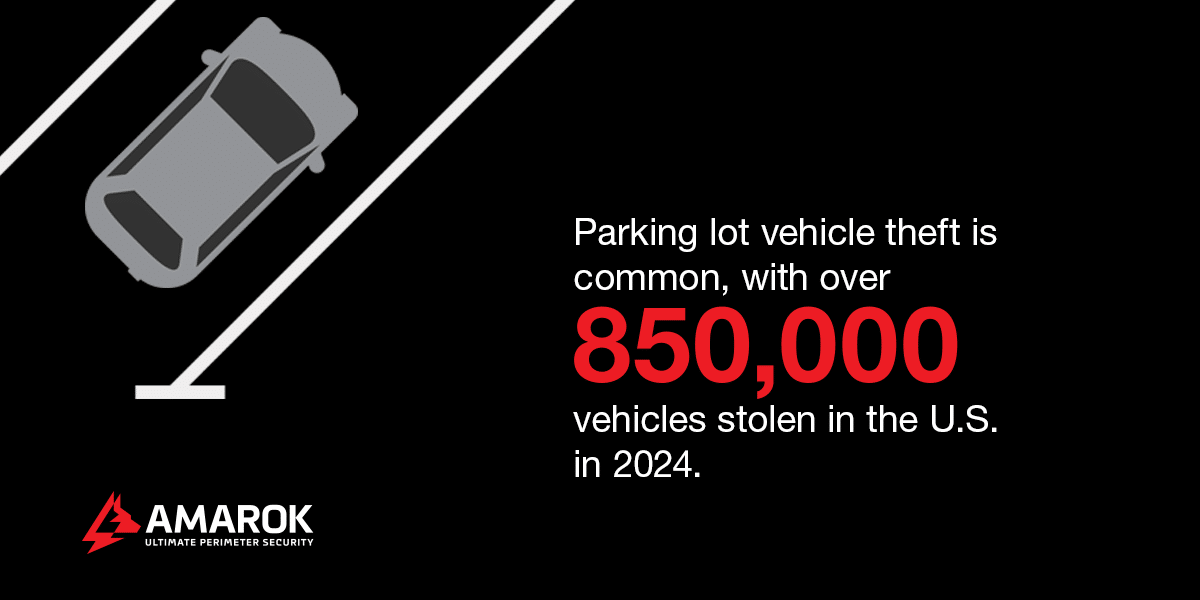Modern commerce demands convenient parking solutions. Operations ranging from manufacturing and distribution hubs supplying goods to data centers securing informational assets need to have parking available for employees and guests.
Yet, the layout and location of many parking areas create natural opportunities for thieves. Isolated stairwells, dark corners, and remote spaces create security weaknesses for criminals to exploit. Understanding the importance of parking lot security and how to maximize it helps your business reduce its risk exposure.
The Importance of Parking Lot Theft Prevention
Parking lots often combine public accessibility with poor sightlines and abundant hiding places, making them popular targets for criminals. Here’s what your business needs to know about parking lot crimes.
What Are the Most Common Types of Parking Lot Crime?
Common parking lot crimes include:
- Vehicle theft: Parking lot vehicle theft is common, with over 850,000 vehicles stolen in the U.S. in 2024. The District of Columbia had the highest theft rate, with 842.40 thefts per 100,000 people. California was second, with 463.21 thefts per 100,000 people. Theft from parking lots is even easier when the facility or business does not have perimeter security measures in place.
- Larceny from vehicles: Larceny-theft of property or accessories from vehicles is the most common form of larceny theft in the U.S. after shoplifting, with over 1.3 million combined incidents in 2023. Parking lots are prime targets due to high turnover and vehicles left unattended for long periods. Catalytic converters are common targets for parts theft. Theft of catalytic converters surged in the early 2020s, and one Sacramento man stole 73 units from a single service yard in 2024.
- Vandalism: Vandalism in a parking lot can include keying, slashing tires, breaking windows, painting graffiti, and damaging mirrors or lights. These incidents can cause significant financial loss and harm a business’s reputation. Unprotected lots with surveillance blind spots are most vulnerable.
- Violent crimes: Parking lots are common locations for violent crimes, including carjacking, armed robbery, assault, and kidnapping. For example, there were almost 17,000 robberies in parking lots, drop lots, and parking garages nationwide in 2023. Poor lighting, isolated areas, and a lack of perimeter security or surveillance increase a lot’s vulnerability. Areas with high foot traffic or 24/7 access are especially susceptible.

Which Businesses Experience Parking Lot Theft?
While any parking area can experience crime, some properties naturally attract more thieves. These include businesses like:
- Manufacturing and distribution: Parking lots at manufacturing and distribution hubs attract thieves because they often contain high-value company vehicles and expensive equipment that’s frequently left unattended.
- Data centers: Parking lots at data centers have specialized service vehicles and attract criminals who like to target physical assets and sensitive information.
- Car rentals: Car rental lots are frequent targets because they house large inventories, making them appealing for both vehicle theft and parts stripping.
- Vehicle fleets: Fleet management yards are at risk because they store multiple commercial vehicles, often with valuable tools or cargo inside.
- Airport parking: Parking lots at airports and train stations are targeted due to the fact that vehicles are parked and left unattended for extended periods of time.
- Equipment rentals: Lots at equipment rental centers are vulnerable to theft due to the presence of expensive machinery and tools that can be easily resold.
- Auto auctions: Auto auction lots attract criminals since there are hundreds of vehicles in one location, often with limited staff presence after hours.
- Auto services: Vehicle repair shop parking lots are vulnerable to theft and vandalism due to customer vehicles, valuable auto parts, and tools left unsupervised overnight or on weekends.
- Trucking: Trucking company yards have high-value cargo, trailers, and fuel. Large, open lots at these locations can also be difficult to monitor.
- Truck sales and service: Lots at truck sales and service centers attract criminals due to expensive commercial vehicles that are often stored in expansive lots with limited after-hours security.
What Are the Consequences of Parking Lot Crimes?
Financial costs arising from theft can be substantial. Businesses may lose their assets or be liable for reimbursing their customers. Damage to the brand’s reputation also translates to lost revenue if customers turn to a competitor.
Time devoted to filing claims with insurance companies can erode profitability, too. Every minute you spend on the task means less time for growing your business. Additionally, your insurance costs will likely increase. A single car theft can raise premiums by 20%. In many cases, the carrier even denies the claim based on technicalities.
Crimes could also create a hazardous environment for your team members. What if a thief approached your staff, or they caught a criminal in the act? As the employer, the Occupational Safety and Health Administration (OSHA) makes you responsible for a safe workplace. Physical harm to an employee from a known and preventable hazard could lead to legal liabilities and OSHA penalties.
Security guards alone aren’t enough to detect, deter, and delay criminals. In larger parking lots, observant thieves can time their crimes. They simply wait to act until guards’ rounds take them to the other side of the property.
Fortunately, highly effective parking lot security solutions exist, especially when integrated into a comprehensive, layered strategy. A thorough property threat assessment will help you design parking lot theft prevention solutions that address your specific risks.

Preventing Parking Lot Crime: 8 Security Solutions
Consider implementing combinations of the measures below based on your property and guests’ needs.

1. Fencing
Fencing forms the bedrock of effective perimeter security. Aside from access control, it’s the only solution that proactively keeps criminals off your property. For example, options like video surveillance won’t deter a determined thief who believes the reward outweighs the risks.
Choose from various construction materials that simultaneously boost aesthetic appeal and parking lot security. Examples include:
- Wood
- Vinyl
- Stone
- Composite
- Concrete
- Metal
Further, all the materials listed above are compatible with an electric fencing system installed within the existing outer one. Nothing stops crime like a safe, legal electric fence, which provides a physical barrier and visual deterrent. Pulsed electricity and controlled current deliver a safe but memorable shock that makes criminals think twice about attempting a breach.
Electric fencing also integrates with other security layers to create a comprehensive strategy. For extra peace of mind, add integrated video surveillance with live monitoring or fence alarms and lighting to draw attention to criminal activity. Various enhancements can increase your electric fence’s performance even more. Consider options like angled fencing and lay-down fencing that prevent thieves from accessing the property from above or by digging beneath.
2. Lighting
While not all crime happens at night, car theft and armed robberies are more likely to occur then. The reason is simple — darkness makes these activities and threats more challenging to identify. As a result, lighting is a fundamental way to boost security in parking lots.
Lights naturally increase visibility, which deters crime and makes safe navigation easier. Additionally, passersby can better observe what is happening within the lot, serving as a form of natural surveillance. A bright, well-lit area also instills comfort in visitors to the property.
Choose ultrabright LED bulbs for energy efficiency and pair them with automatic sensors for more cost-effectiveness. It’s also prudent to consider backup power sources to ensure continued visibility during outages. Lighting types and installation areas to consider include:
- Floodlights at parking facility entrances and exits
- Small directional lights for all signage
- Spotlights near security cameras to enhance video clarity and footage visibility
- Wall-mounted options along your perimeter
- Area lights placed evenly throughout the lot between parking spaces
Additionally, you can find options that seamlessly integrate lighting with alarm systems. When a thief sets off the alarm, they also trigger spotlights nearby, providing more incentive to flee.
3. Video Surveillance and Monitoring
Surveillance cameras add another layer of security to a multipronged strategy. While they aren’t stand-alone solutions to preventing crime, security cameras offer key benefits:
- Real-time visibility
- Visual deterrence
- Dual verification for law enforcement response
- Image capture and archival
Today’s options offer more versatility than ever, as you can invest in:
- Pan-tilt-zoom styles that can automatically adjust to provide 360-degree visibility.
- Motion- and voice-activated models that respond to activity and emergencies within a defined area.
- License plate recognition options, powered by artificial intelligence, that capture traffic.
- Two-way audio cameras that allow security teams to warn criminals that their presence is known.
- Wide Dynamic Range styles that automatically balance contrast to eliminate glare.
- Fixed, damage- and tamper-resistant security cameras to cover doorways and stairwells.
To enhance video surveillance further, consider adding 24/7 remote video monitoring to your camera system. This proactive approach leverages highly trained professionals and video analytics to watch over your property around the clock. The combination helps identify potential threats sooner, enabling an immediate response to limit the scope of an incident.
4. Access Control
Access control is a foundational principle in Crime Prevention Through Environmental Design theory. This framework stresses using physical barriers to manage property traffic, helping deter and delay unauthorized access.
Common access control measures range from stationary fixtures to manual authorizations and automatic electronic solutions, including:
- Door locks requiring a code
- Credential readers for badges, key fobs, or QR codes
- Staffed entry and exit points
- Bollards
- One-way spike strips
- Intercoms and video cameras
Gates present an opportunity for another popular access control solution — gate access control systems — and come in numerous styles to meet your parking area’s needs. Gate access control measures for commercial parking spaces include:
- License plate recognition technology with AI cameras.
- Sliding gates with badge readers or code entry boxes.
- Video and audio intercoms for manual authorization.
- Motorized gates integrated with credential verification systems.
When designing the right access control strategy for your property, it’s best to consider exits as carefully as entries. Parking areas that manage departing traffic are less attractive to thieves who want a quick way out. The more challenging it is to plan a clean exit after criminal activity, the less likely a thief will target your business.
5. Employee Training
Your employees, whether vehicle owners or hired security personnel, are key to preventing parking lot crimes on your property. Educating them on suspicious behaviors and empowering them to escalate their concerns can help stop theft. Encourage them to be observant and report unusual behavior like:
- Vehicles that change spaces frequently throughout the day.
- People who approach an employee and ask questions about security, staffing, and hours.
- Cars that are parked for unusually long periods with someone inside.
- Vehicles that circle the property or enter and exit repeatedly without parking.
- Anyone attempting to open multiple vehicle door handles or removing license plates.
- People leaning against vehicles, circling them, or looking inside them as they meander the lot.
- Those exhibiting nervous tendencies, like continuously looking around or fixing their clothing.
- Drivers entering or exiting the lot at night without headlights on.
- After-hours loiterers.
- Sounds that could indicate criminal activity, such as glass breaking.
- Impersonators — for example, someone dressed as a security guard when your property doesn’t employ them.
It’s also prudent to invest in basic safety education for your staff so they can navigate potential threats more confidently. Guidance to consider includes:
- Attend training on security systems to learn how to properly arm and disarm them.
- Choose smart parking spaces nearest the building and underneath lighting whenever possible.
- Stay aware of the surroundings and report people or activity that seems suspicious.
- Avoid distractions like smartphones while traveling through the lot.
- Do not approach or enter a vehicle with visible signs of damage, such as a broken window or slashed tires.
- Know how to activate emergency beacons, a vehicle’s panic alarm, or a cell phone’s emergency SOS setting.
- Have keys handy before reaching the vehicle, and exit the lot promptly.
- Always lock vehicles when exiting, and remove valuables or leave them at home.
6. Signage
Signage is a fundamental way to boost parking lot security by providing crucial information for guests and warning would-be criminals. Examples of signs to consider include:
- Visual deterrents that warn of security measures in use on the property, such as video surveillance or roving patrols.
- Areas where parking is prohibited and towing policies.
- Wayfinding solutions to help authorized visitors navigate their paths successfully.
- Reminders for patrons to lock their doors, remove personal belongings, and avoid leaving valuables in their vehicles.
- Markers for restricted-access areas or entryways.
- Emergency contact information for local authorities or property management.
- Locations of emergency equipment, call boxes, or beacons.
- Row numbers or letters that help visitors remember where they parked.
- Instructions for payment and locations of payment kiosks.
- Hours of operation.
- Activities prohibited on the property.
Depending on your security strategy and jurisdiction, you may be required to post other signage. For example, California parking lots that install electric perimeter fences must follow Civil Code Section 835 Chapter 9 regulations. These laws mandate a warning sign at least every 30 feet. Similar rules can apply at municipal levels, so it’s vital to research what your local authorities require.
Once you’ve chosen and installed your signs, revisit your lighting approach to ensure they’re readily visible at all hours.
7. Emergency Stations
Unexpected events occur in parking facilities, such as a stolen vehicle, theft of belongings, or a criminal threat. When emergencies arise, people want to know that help is readily available. Emergency stations provide that assistance, putting guests in contact with a professional immediately to facilitate an appropriate response.
Modern options range from wall-mounted call boxes to towers with push-button beacons that quickly pinpoint the requester’s location. Cameras with intercom capabilities are also available, providing security personnel with real-time video footage to inform their response. When designing an emergency station strategy, consider the following:
- Place stations equidistant throughout the lot to ensure one is nearby when someone’s in need.
- Add directional signage and lighting so a patron can easily locate and use the system, day or night.
- Evaluate the traffic volume nearby — remote areas may require more planning to ensure visibility and accessibility.
Of course, not every occurrence is a genuine emergency or presents an immediate threat. Post instructions near stations for requesting non-emergency assistance, such as flat tires or dead batteries. You can also provide alternate reporting methods for suspicious vehicles, persons, or activity to avoid confrontations with potential intruders.
8. Property and Equipment Maintenance
Keeping your parking lot well-maintained and looking its best is another way to help promote higher security.
For example, many companies invest in landscaping to improve their parking area’s visual appeal and add a physical barrier against entry. Trim and control the vegetation to help eliminate hiding places. Allowing excess debris or abandoned vehicles to collect on the property poses similar issues with concealment possibilities. Quickly clearing them shows visitors and would-be criminals that you care about the area and pay attention to it.
You’ll also want to design a strategy for regular equipment maintenance, ensuring each component of your layered approach is functional. Develop a property upkeep checklist that includes regular inspections of the following and any other critical items:
- Lightbulbs and fixtures
- Surveillance cameras and wires
- Access control solutions and credential readers
- Intercoms
- Emergency stations and call boxes
- Signage
Contact your trusted property maintenance or security system professionals for any items that appear to need replacement or repair.
Secure Your Parking Lot Perimeter With AMAROK
Protecting your business and its reputation means investing in effective, layered parking lot security solutions. Start at the perimeter with AMAROK and benefit from security-as-a-service that comes at a manageable monthly fee. Our safe, legal, and proven electric fencing options and integrated systems stop 99% of external theft for over 8,000 businesses. Let us do the same for you with no upfront installation, maintenance, or repair costs.
Learn how we outperform security guards and save money by contacting your local security expert or reaching out online.





